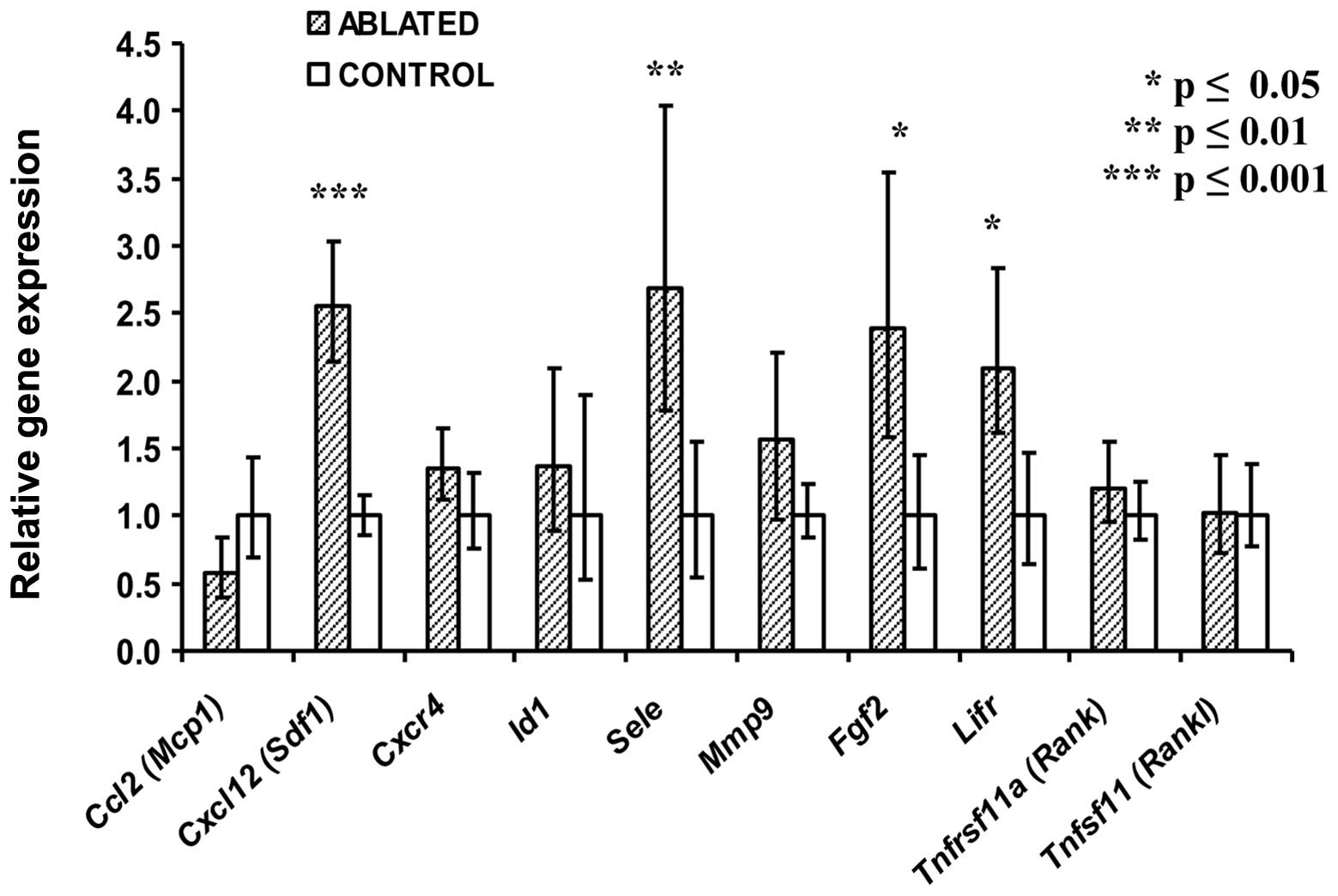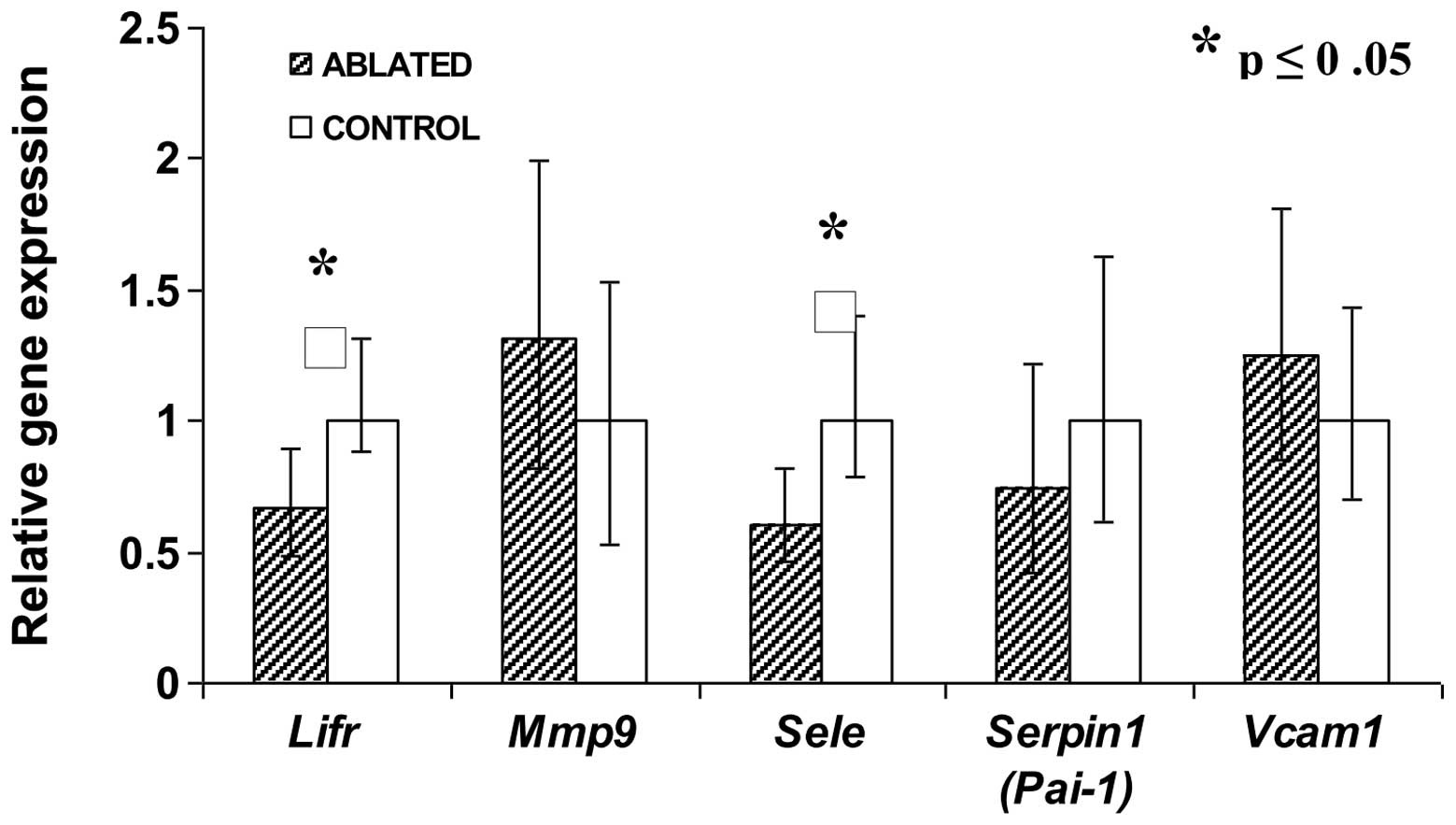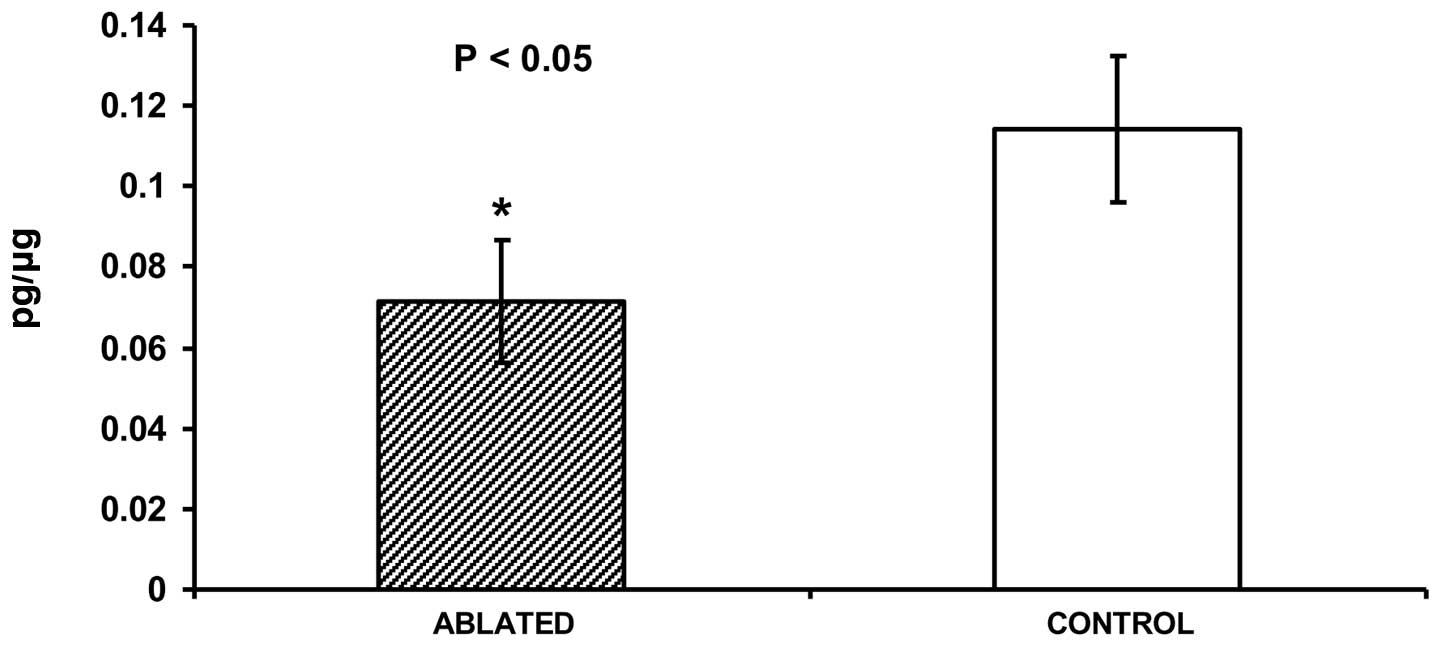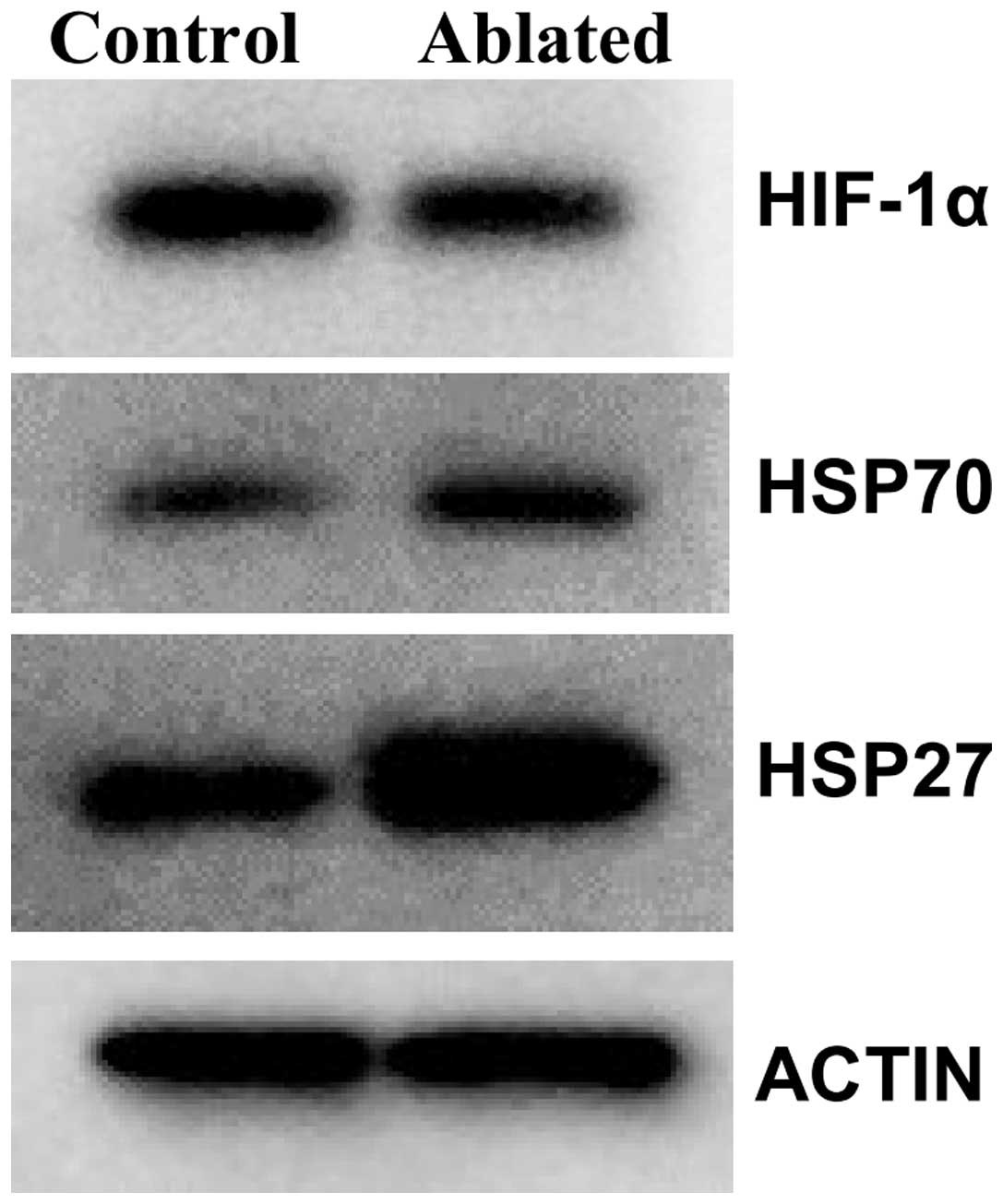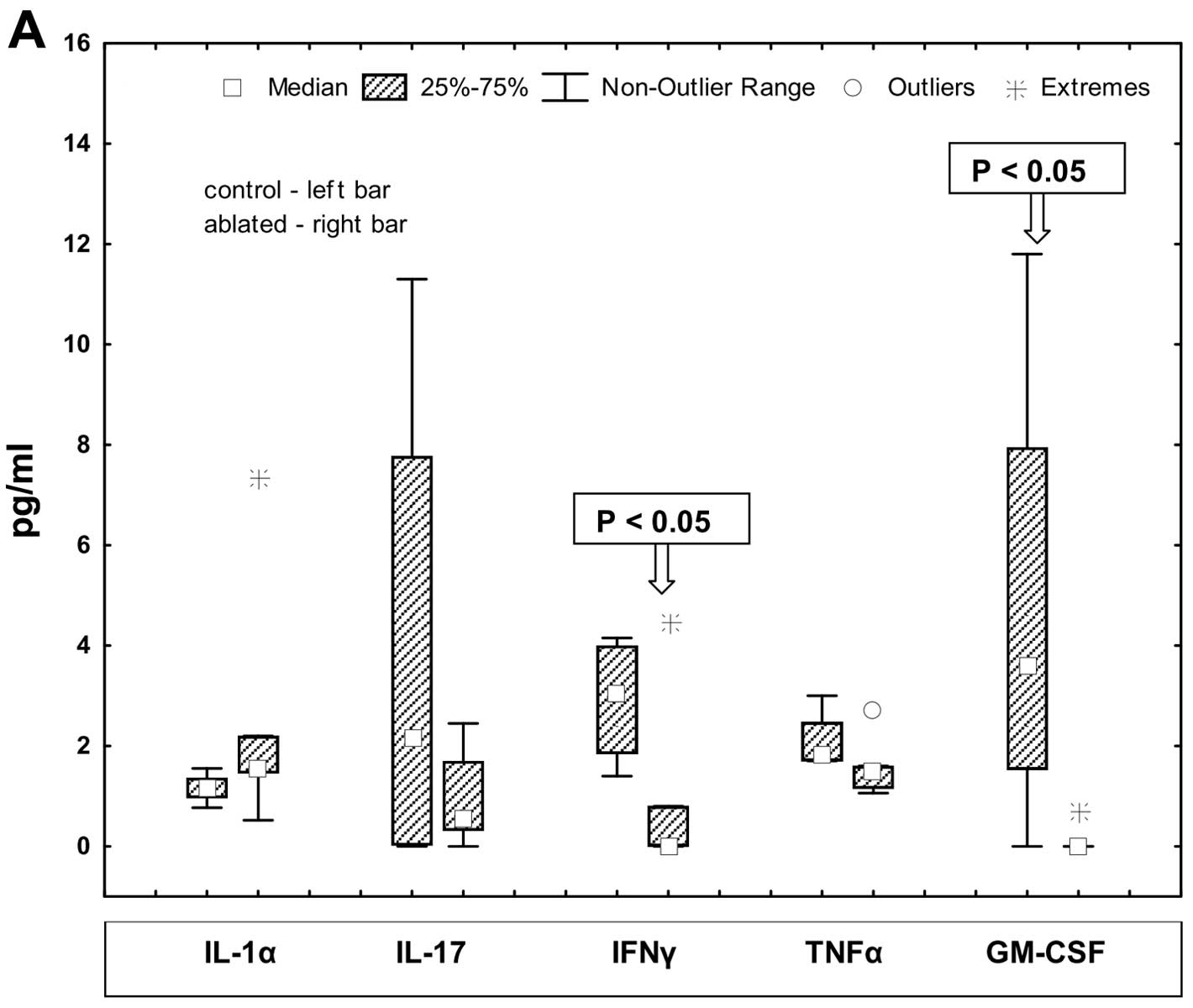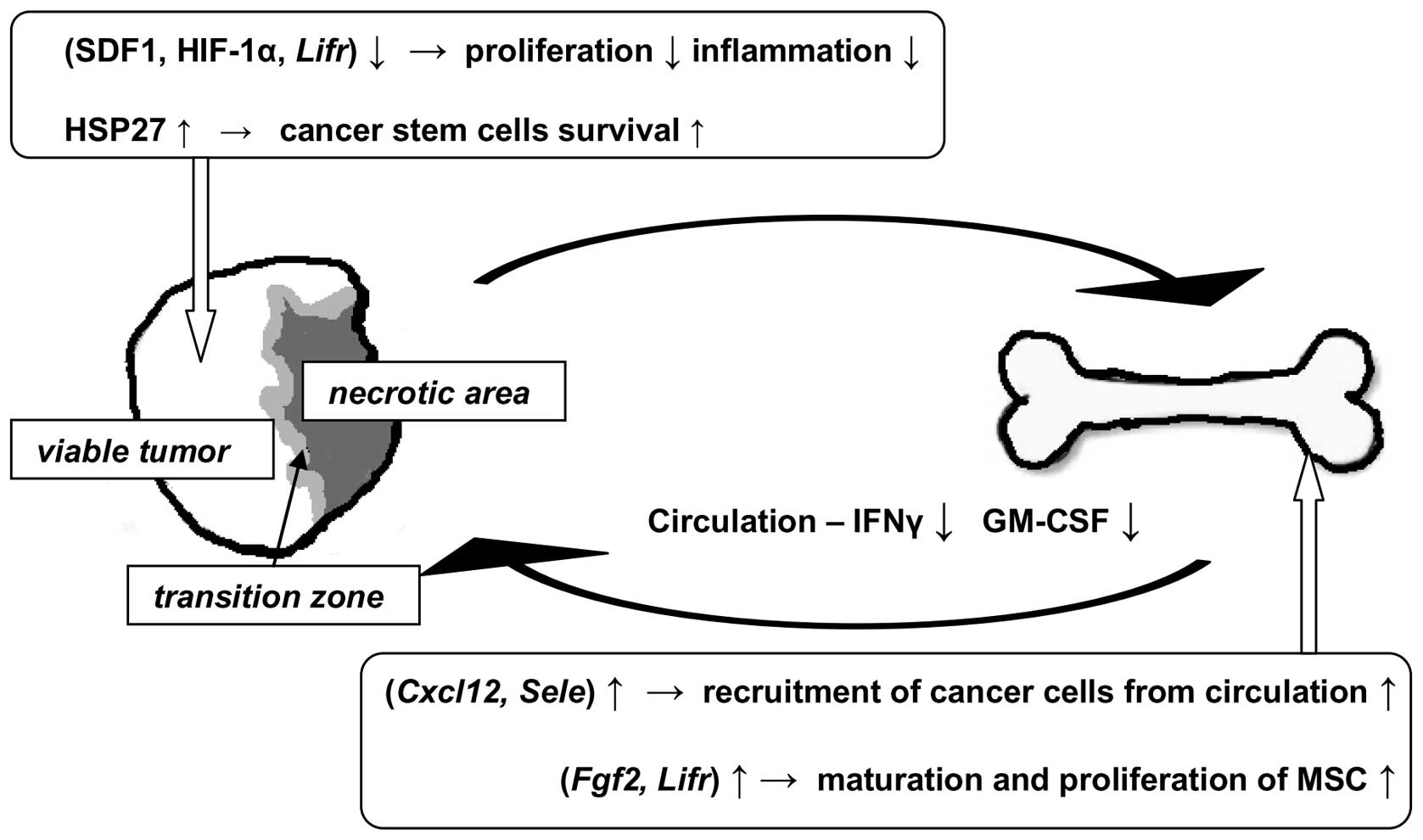Molecular changes in bone marrow, tumor and serum after conductive ablation of murine 4T1 breast carcinoma
- Authors:
- Published online on: November 21, 2013 https://doi.org/10.3892/ijo.2013.2185
- Pages: 600-608
Abstract
Introduction
Thermal ablation therapy destroys cancer cells by delivering electromagnetic or acoustic energy [e.g. radiofrequency (1), laser (2), or focused ultrasound (3)] that is converted to heat in the target tissue. The therapy raises the temperature of the ablation site to between 56 and 100°C which results in irreversible damage by coagulation necrosis. Preclinical study with conductive interstitial thermal therapy (CITT) (4), (5) has demonstrated decreased metastasis in rabbits with VX2 tumors (6) and the reduction of hypoxia in tumor tissue surviving partial CITT ablation of murine breast carcinoma (7). Investigating the molecular changes associated with CITT and with other thermal ablation therapies may identify biomarkers that facilitate development of methods for monitoring and predicting the potential for therapy-associated enhancement of tumor re-growth, and metastasis.
Histological analysis of thermal ablation lesions in animal models has revealed three regions. The central region is adjacent to the ablation (i.e. area of probe insertion, or focus of ultrasound) and contains necrotic tumor tissue. Massive tumor debris appears to result in release of immunogenic factors (8). Adjacent to necrotic area is a coagulation margin that defines a sharp transition zone between necrotic and viable tissue. This highly hypoxic region was shown to be a site of accelerated tumor re-growth after radiofrequency ablation (9). A third region is more distant from the center of heat delivery and contains viable tumor tissue. In this region, we observed decreased hypoxia 72 h after CITT ablation (7). Thus, lesions of ablated tumor appear to possess areas with different properties that may have the potential to initiate induction of tumor re-growth (undesirable effect), stimulate antitumor immunity and decrease hypoxia (desirable effects).
Our research is interested in the mechanisms by which thermal tumor ablation affects communication between tumor tissue, bone marrow and sites of metastasis. Recent progress in understanding tumor biology has revealed crucial roles for the bone marrow in carcinogenesis, tumor growth and metastasis. Cytokines and growth factors secreted by tumor into circulation stimulate release of a variety of cells from bone marrow. These molecules contribute to tumor growth, vascularization, and regulation of immune cells in the tumor microenvironment (10,11). However, little is known about the effects of thermal ablation upon the interactions between tumors, bone marrow, and site of metastasis. Thus, characterization of the molecules that potentially mediate these communications in the context of tumor growth and treatment would be an important step towards understanding the mechanisms underlying different outcomes of thermal tumor ablation.
The study presented here reports the preliminary results of quantitative analysis of gene expression and protein levels for serum, marrow and surviving tumor collected 72 h after partial ablation of 4T1 carcinoma in BALB/c mice. The CITT treatment protocol was designed to result in only partial tumor ablation to enable characterization of the remaining surviving tumor tissue. The study hypothesized that tumor ablation would broadly affect gene expression (Table I) and protein (Table II) levels for molecules involved in cell signaling, proliferation, adhesion, angiogenesis and stress response. Candidate molecules were chosen due to evidence in the literature for their role in breast tumor development and spreading, bone marrow homeostasis and tumor responses to thermal stress (12–16).
Materials and methods
Growing 4T1 tumors in BALB/c mice and CITT treatment
The 4T1 mammary carcinoma is a syngeneic mouse model of breast cancer. The 4T1 cell line originated from spontaneously grown, metastatic mammary tumor in BALB/c mice. This mammary tumor has many characteristics of human invasive breast cancer (17). The thermal ablation procedures were described in detail in our previous study (7). The use of BALB/c mice (Jackson Laboratories, Bar Harbor, ME, USA) and the experimental protocol was approved by the University of Arkansas for Medical Sciences Institutional Animal Care and Use Committee. The 4T1 cancer cells (2×105) were injected subcutaneously into the right rear leg of each mouse. When tumor reached 10–12 mm in size, the mice were anesthetized with 1–2% isofluorane and a CITT probe, without pin deployment, was inserted in the center of a tumor. Temperatures were monitored with two thermocouples, one next to the tip of the CITT probe and another one, at the periphery of the tumor. Ablation was performed for 10 min with temperature maintained within the range 80–90°C (next to the CITT probe) while the peripheral tumor temperature remained in the low to mid 40°C range. Each mouse had one tumor. Five mice with tumors were ablated and four mice with tumors were used as untreated control.
Sample preparation
The mice were scarified 72 h after ablation. At this time point necrotic area is well established and the transition zone separating necrotic area from viable perinecrotic zone is clearly visible on tumor sections. The entire tumors were removed immediately after necropsy. One half of the tumor was used to prepare fresh sections in order to record the size of the ablated areas with a viability staining, triphenyltetrazolium chloride (TTC) as previously described (18). The other half of the tumor was used to prepare tissue samples from viable portion of tumors which were cut into pieces ranging from 50–100 mg, frozen in liquid N2 and stored at −80°C until use. Femurs and tibiae were carefully cleaned from adherent soft tissue and placed in cold, sterile phosphate buffered saline, followed by transfer to Petri dish filled with Dulbecco’s modified Eagle’s medium (DMEM). The ends of bone were cut off with sterile scissors so that the bone marrow could be flushed with DMEM using a 3cc syringe and 27G needle. The cells suspensions were filtered through 70-mm BD Falcon nylon mesh (Fisher Scientific Inc., Sewanee, GA, USA). Cells were counted (Beckman Coutler Z series System, Hialeah, FL, USA), centrifuged at 1410 rpm for 5 min at 4°C, and re-suspended in serum free DMEM at a concentration 1×106 cells per ml. Aliquots of 1.5 ml of cells were made, centrifuged and the medium was removed so that cell pellets could be frozen in liquid N2 and stored at −80°C until use.
Total RNA isolation and preparation of cDNA
Total RNA was isolated from frozen tumor and bone marrow cell pellets using the RNAqueous-4PCR kit (Ambion/Applied Biosystems, Foster City, CA, USA) according the manufacturer’s instructions. RNA concentration was determined with ND-1000 Spectrophotometer (NanoDrop Technologies, Inc., Wilmington, DE, USA) and RNA integrity was verified with Bioanalyzer (Applied Biosystems). All RNA samples possessed an RNA integrity number (RIN) >7. cDNAs were prepared from 2 μg of RNA using iScript cDNA Synthesis kit (Bio-Rad Laboratories, Inc., Hercules, CA, USA). This kit contains blend of oligo dT and random hexamers primers. The cDNAs were stored at −20°C in 5–10 μl aliquots. A pooled sample of all cDNAs was also prepared to use in primer testing and optimization of standard curves.
Quantititative RT-PCR
Primers used in the real-time polymerase chain reaction (RT-PCR) were designed using the murine NCBI nucleotides database and Primer Express v3.0 software (Table III). RT-PCR assays were performed according to the manufacturer’s instructions using iTaqSYBR Green Supermix with ROX (Bio-Rad Laboratories Inc.), 384-well plates, and the ABI Prism 7900 Sequence Detection System (Applied Biosystems). For each transcript of interest standard curves were evaluated in order to optimize the primer concentration for maximum reaction efficiency. Standard curves were prepared from five-fold serial dilution of pooled cDNA. Gene expression was normalized to both 18S ribosomal RNA and glyceraldehyde 3-phosphate dehydrogenase (GAPDH). The comparative CT (ΔΔCT) method for calculating relative gene expression was used to evaluate differences in levels of transcripts between control group (mice with non-treated tumors) and treated group (mice with ablated tumors) (19). The fold change of transcripts was calculated using DataAssist v3.0 software (Applied Biosystems).
Quantification of chemokines in serum
Blood was collected by cardiac puncture of anesthetized mice just before euthanasia. Isolated serum was aliquoted for storage in −20°C. Cytokines in serum were quantified with the Cytokine 16-plex panel (Quansys Biosciences, Inc., Logan, UT, USA). This chemiluminescent Quansys Q-plex Array contained IL-1α, IL-1β, IL-2, IL-3, IL-4, IL-5, IL-6, IL-10, IL-12, IL-17, MCP-1, IFNγ, TNFα, MIP-1α, GM-CSF and RANTES antibodies absorbed to each well of a 96-well plate (Table II). The lower level of detection was different for each cytokine and ranged from 0.1 pg/ml (TNFα) to 5.0 pg/ml (MCP-1). Serum samples were tested in triplicate. Data were collected using Q-View Imager and software (Quansys Biosciences Inc.). Results are presented in picograms of cytokine per ml of serum (pg/ml).
ELISA
Tumor lysates were prepared from frozen tumors by homogenization in diluted Cell Lysis Buffer 10X (Cell Signaling Technology, Inc., Beverly, MA, USA) containing 1 mM PMSF (phenylmethanesulfonyl fluoride). The total protein concentration of lysates was determined with Pierce BCA Protein Assay kit, (Thermo Fisher Scientific Inc., Rockford, IL, USA), a Synergy HT spectrophotometer and the Gene5 software (BioTech Instruments, Winooski, VT, USA). The level of stromal derived factor 1 (SDF-1, also known as chemokine CXCL12) in the lysates was determined using Duo Set ELISA Development kit, according the manu facturer’s instructions (cat # DY460, R&D Systems, Inc., Minneapolis, MN, USA). Samples were assessed in triplicate. The results are presented as picograms of SDF-1 protein per micrograms of total protein content of the tumor lysate.
Western blotting
Tumor lysates for immunoblotting were prepared as described above for ELISA. Novex Pre-Cast gradient gels (4–20%) and NuPAGE Electrophoresis system (Invitrogen Life Technologies, Inc., Carlsbad, CA, USA) were used to resolve proteins from 8 μg of total protein sample per well. Western transfer onto polyvinylidene difluoride membranes (Amersham, Piscataway, NJ, USA) was performed in an XCell II Blot Module (Invitrogen Life Technologies, Inc.). After protein transfer, membranes were stored at 4°C. For immunoblotting, membranes were incubated in 10% fat-free powdered milk solution for 4 h at room temperature (RT). Primary antibodies were applied for 1 h at RT, the membrane was washed, and the secondary antibody was applied for 1 h at RT. The following primary antibodies were used: monoclonal anti-HIF-1α (cat # NB100-105, Novus Biologicals), polyclonal anti-HSP 27 (cat # sc-1049, Santa Cruz Biotechnology), monoclonal anti-HSP 70 (cat # sc-24, Santa Cruz Biotechnology), monoclonal anti-Ki67 (cat # NBP1-40684, Novus Biologicals) rabbit polyclonal anti-MMP9 (cat # ab38898, Abcam) and anti-actin (1–19) (cat # sc1616, Santa Cruz Biotechnology). The secondary antibodies were: anti-mouse (cat # 170-6516; Bio-Rad Laboratories, Inc.), anti-goat (cat # sc-2020; Santa Cruz Biotechnology) and anti-rabbit (cat # sc-2004, Santa Cruz Biotechnology).
Statistical analysis
The two-tailed Student’s t-test was used to analyze RT-PCR and ELISA data. Mann-Whitney U test and Fisher’s exact test were used to evaluate cytokines panel results. The software DataAssist v3.0 (Applied Biosystems) and Sigma Plot v11 (Systat Software Inc., San Jose, CA, USA) were applied.
Results
Effects on bone marrow gene expression
The effects on the bone marrow of BALB/c mice 72 h after tumor ablation by CITT therapy were measured by quantitative real-time RT-PCR. Marrow RNA was assayed for 27 murine transcripts (Table I). Four transcripts were expressed at significantly higher levels for the mice treated with tumor ablation (N=5) as compared to the control mice (N=4) with untreated tumors (Fig. 1). Transcript levels for genes encoding stromal derived factor 1 (Cxcl12), E-selectin (Sele), leukemia inhibitory factor 1 receptor (Lifr) and basic fibroblast growth factor (Fgf2) ranged from an average of 2 to 2.5-fold higher (P<0.05) in the treated as compared to the untreated mice. Transcripts of other genes such as chemokine ligand-2 (Ccl2) and chemokine receptor-4 (Cxcr4) were not affected in bone marrow by tumor ablation (Fig. 1). Four other examples of transcripts unaffected by the treatment are also shown.
Effects on surviving tumor gene expression
The effects on viable 4T1 tumor surrounding the site of partial ablation were also measured by quantitative real-time RT-PCR. Tumor RNA was assayed for 27 murine transcripts (Table I) for treated (N=5) and control mice (N=4). Two transcripts were expressed at significantly lower levels for the mice treated with tumor ablation (N=5) as compared to the control mice (N=4) with untreated tumors (Fig. 2). Transcript levels of Lifr and Sele genes for treated tumors was only ∼60% as high as the control tumors (P<0.05). Transcripts of other genes such as matrix metallopeptidase-9, serpin-1 and vascular cell adhesion molecule-1 were not affected in tumor tissue that survived ablation (Fig. 2).
Effects on surviving tumor protein level
The effects of partial tumor ablation on protein levels in viable tissue around the site of ablation 72 h after treatment were measured by immuno assays. As measured by ELISA, levels of SDF-1 protein in tumor lysates were significantly lower (0.071±0.016 pg/μg versus 0.113±0.017 pg/μg, P<0.05) for ablated (N=4) as compared to control (N=3) tumor tissue (Fig. 3). Levels of six proteins were measured in tumor lysates using western immuno blotting (Table II). A representative blot showing results for these proteins and actin, a control protein, are presented (Fig. 4). Levels of heat shock proteins HSP70 and HSP27 were higher for all individual samples for ablated (N=5) as compared to control (N=4) tumor tissue; whereas levels of hypoxia inducible factor (HIF-1α) were consistently lower for ablated tumors. Protein levels for matrix metallopeptidase-9 and antigen Ki-67 were unaffected by the treatment (data not shown).
Effects on serum cytokine levels
The effects of partial tumor ablation on serum cytokine levels 72 h after treatment were measured by multiplex immunoassay. The results for 10 of the 16 cytokines are presented (Fig. 5). The cytokines IL-1α, IL-17, IFNγ, TNFα and GM-CSF were present in serum at low concentrations. Other cytokines including IL-1β, IL-5, IL-6, MCP-1 and RANTES were present at higher concentrations. These ten cytokines were present at detectable levels in serum from at least five of the nine study mice and the inter-sample variability within groups was large. Only two cytokines, interferon-γ (IFNγ) and granulocyte-macrophage colony-stimulating factor (GM-CSF) showed significant differences between groups. IFNγ and GM-CSF had a significantly lower level in serum from the ablated mice as compared to control mice (P<0.05). Notably, interleukin-1β showed a trend towards lower values (P=0.154) in serum from ablated mice.
Discussion
Thermal ablation has been used to treat tumors of the liver (20), prostate (21), and breast (22–24) in humans and animal models. Results of these therapies can vary greatly depending on many variables, including ablation modality, operator techniques and tumor site. For example, radiofrequency ablation can lead to accelerated perinecrotic outgrowth of colorectal liver metastases (25); whereas, we previously demonstrated that CITT therapy decreased metastasis in rabbits with VX2 tumors (6). In the current study, a mouse mammary carcinoma model was used to characterize the molecular changes that occur in serum, bone marrow, and tumor surviving partial ablation. At the transcriptional level, ablation increased Sele, Fgf2, Lifr and Cxcl12 in marrow and decreased Lifr and Sele in the surviving tumor. At the protein level, ablation resulted in decreased levels of SDF1 and HIF-1α and increased levels of HSP27 and HSP70 in the surviving tumor. In serum, ablation decreased the concentration of the IFNγ and GM-CSF. Thus, 10 molecules have been identified that may be involved with alteration of communication between the marrow and tumor as well as alteration of homeostasis in surviving tumors.
The bone marrow responded to thermal ablation with an increase in the Sele, Fgf2, Lifr and Cxcl12 transcripts. Sele encodes E-selectin, an adhesion molecule expressed by activated endothelial cells while tumor cells express E-selectin ligands. Interactions between these cell types through E-selectin are thought to regulate cancer metastases (26). Thus, the possibility exists that increased E-selectin could promote adhesion of cancer cells and enhance seeding tumor cells into the marrow. Fibroblasts growth factor 2 is a stromal cell mitogen and stimulates myelopoiesis in marrow. However, in the presence of advanced, untreated human breast and lung tumors, low levels of Fgf2 result in an arrest of maturation of mesenchymal stromal cells in marrow (27). The response of Fgf2 to ablation seen here may be an attempt of the marrow to re-establish normal maturation for mesenchymal cells.
Leukemia inhibitory factor (LIF) is a cytokine that also affects marrow mesenchymal cells (28,29). Upregulation of the LIF receptor transcript (Lifr) in marrow may indicate that tumor ablation influences not only maturation but also differentiation of mesenchymal stromal cells. Stromal derived factor 1 is a signaling molecule for communication between tumor and marrow (30,31). The SDF1 receptor (CXCR4) is expressed on breast and other epithelial cancer cells and has been shown in multiple studies to be involved with metastasis (32–35). Increase of expression of the Cxcl12 transcripts encoding SDF1 in bone marrow may stimulate mobilization and recruitement of immature hematopoietic cells, endothelial and smooth muscle progenitor to neo-angiogenic niche (36,37). However, it is unknown whether or not the elevation of Cxcl12 transcript found in marrow post-ablation is evidence of seeding premetastatic niches or the primary tumor site. In summary, four transcripts have been identified which respond in marrow to tumor ablation. Further investigation is needed to confirm whether or not their encoded proteins play a role in mesenchymal cells development or tumor dissemination after thermal ablation.
Tumor tissue responded to thermal ablation with a decrease in SDF1 and HIF-1α proteins, and an increase in HSP27 and HSP70 proteins, and decreases in Lifr and Sele genes transcripts. Our work previously showed that thermal ablation decreases hypoxia in surviving tumor areas (7). The results presented here are consistent with this effect in that SDF1 and hypoxia inducible factor 1 (HIF-1α) are lower in treated than untreated tumors. These changes could inhibit the metastatic potential of surviving tumor cells or inhibit signaling between the marrow and tumor for the recruitment of cells supportive of tumor growth such as pro-angiogenic endothelial progenitor cells or marrow suppressor cells (32,35,38,39). The increase in heat shock proteins -70 and -27 after treatment may be a stress response. Unfortunately, HSP70 may be acting to protect the cancer cells as its expression has been associated with poor prognosis (40). However, HSP70 may also be indicative of a boost in antitumor immune activity post-ablation (41). Heightened tumor HSP27 is also associated with poor prognosis and metastasis (42) though evidence indicates multiple potential roles in tumorigenesis including promotion of tumor growth (43), regulation of epithelial-mesenchymal transition (44), and conferral of chemo-resistance (45). The increase of HSP27 implies that this heat shock protein should be closely monitored during thermal ablation of tumors and may be a useful marker to assist in determining appropriate treatment regimens in combination with thermal ablation. The effects of ablation on the Sele and Lifr genes were the opposite in tumor to that of marrow where we proposed that these factors may be involved with metastasis and mesenchymal cell development. It would be beneficial if the decrease seen in tumor was the result of a dampened potential for tumor cell proliferation and metastasis post-treatment. In summary, two transcripts and four proteins have been identified which respond in tumor tissue to ablation though additional pre-clinical studies are needed to define their functions and understand whether these molecules are involved with pro- or anti-tumorigenic responses after thermal ablation.
Serum analysis revealed that thermal ablation decreased concentrations of the granulocyte-macrophage stimulating factor (GM-CSF) and interferon-γ (IFNγ). These molecules function in inflammation and the immune response. Their levels are influenced both by the presence of solid tumors (46,47) and thermal ablation (48). However, the significance of their low levels post-ablation is unknown. These cytokines may be indicative of decreased need for antitumor immune function, immunosuppression by the treatment, or they may be associated with slowed tumor growth or smaller number of tumor cells after partial ablation (49,50). Future studies will be needed to determine the source, effects and meaning of low systemic levels of these cytokines three days after ablation therapy.
The major findings and proposed implications of the study are summarized in Fig. 6. Thermal ablation appears to decrease local and systemic decrease of inflammation. Proliferation of viable tumor cells may decrease but HSP27 may indicate the presence of a protected population of surviving cancer cells that may be responsible for aggressive tumor re-growth. Additionally, thermal ablation caused upregulation of genes in bone marrow that are associated with maturation and proliferation of mesenchymal stem and hematopoietic cells to possibly replenish immune cells used during the initial response to trauma. The increase of gene expression encoding SDF1, a ligand for cancer cells, could increase the risk for circulating cancer cells to establish themselves in marrow. We conclude that thermal ablation clearly impacts transcript and protein levels of molecules that may be involved in pro- and anti-tumor activity in the tumor itself, in bone marrow and in serum. However, additional studies are needed to determine the influence of these changes on cell phenotype and their significance relative to cancer host or patient outcomes.
Abbreviations:
|
CITT |
conductive interstitial thermal therapy |
Acknowledgements
We thank Jessica S. Webber for excellence in performing animal experiments and Azemat Jamshidi-Parsian for help in preparation of western immunoblotting assay. This work was supported, in part, by a grant from Fashion Footwear Association of New York (FFANY/QVC) to G.S. and R.J.G. and by NIH grants CA44114 (R.J.G).
References
|
Shah DR, Green S, Elliot A, McGahan JP and Khatri VP: Current oncologic applications of radiofrequency ablation therapies. World J Gastrointest Oncol. 5:71–80. 2013. View Article : Google Scholar : PubMed/NCBI | |
|
Oto A, Sethi I, Karczmar G, et al: MR imaging-guided focal laser ablation for prostate cancer: phase I trial. Radiology. 267:932–940. 2013. View Article : Google Scholar : PubMed/NCBI | |
|
Merckel LG, Bartels LW, Kohler MO, et al: MR-guided high-intensity focused ultrasound ablation of breast cancer with a dedicated breast platform. Cardiovasc Intervent Radiol. 36:292–301. 2013. View Article : Google Scholar : PubMed/NCBI | |
|
Shafirstein G, Hennings L, Kaufmann Y, et al: Conductive interstitial thermal therapy (CITT) device evaluation in VX2 rabbit model. Technol Cancer Res Treat. 6:235–246. 2007. View Article : Google Scholar : PubMed/NCBI | |
|
Shafirstein G, Novák P, Moros EG, et al: Conductive interstitial thermal therapy device for surgical margin ablation: in vivo verification of a theoretical model. Int J Hyperthermia. 23:477–492. 2007. View Article : Google Scholar : PubMed/NCBI | |
|
Shafirstein G, Kaufmann Y, Hennings L, et al: Conductive interstitial thermal therapy (CITT) inhibits recurrence and metastasis in rabbit VX2 carcinoma model. Int J Hyperthermia. 25:446–454. 2009. View Article : Google Scholar : PubMed/NCBI | |
|
Przybyla BD, Shafirstein G, Koonce NA, Webber JS and Griffin RJ: Conductive thermal ablation of 4T1 murine breast carcinoma reduces severe hypoxia in surviving tumour. Int J Hyperthermia. 28:156–162. 2012. View Article : Google Scholar : PubMed/NCBI | |
|
Dromi SA, Walsh MP, Herby S, et al: Radiofrequency ablation induces antigen-presenting cell infiltration and amplification of weak tumor-induced immunity. Radiology. 251:58–66. 2009. View Article : Google Scholar : PubMed/NCBI | |
|
van der Bilt JD, Soeters ME, Duyverman AM, et al: Perinecrotic hypoxia contributes to ischemia/reperfusion-accelerated outgrowth of colorectal micrometastases. Am J Pathol. 170:1379–1388. 2007.PubMed/NCBI | |
|
Peters BA, Diaz LA, Polyak K, et al: Contribution of bone marrow-derived endothelial cells to human tumor vasculature. Nat Med. 11:261–262. 2005. View Article : Google Scholar : PubMed/NCBI | |
|
Bunt SK, Sinha P, Clements VK, Leips J and Ostrand-Rosenberg S: Inflammation induces myeloid-derived suppressor cells that facilitate tumor progression. J Immunol. 176:284–290. 2006. View Article : Google Scholar : PubMed/NCBI | |
|
Di Rosa F: T-lymphocyte interaction with stromal, bone and hematopoietic cells in the bone marrow. Immunol Cell Biol. 87:20–29. 2009.PubMed/NCBI | |
|
Evans SS, Fisher DT, Skitzki JJ and Chen Q: Targeted regulation of a lymphocyte-endothelial-interleukin-6 axis by thermal stress. Int J Hyperthermia. 24:67–78. 2008. View Article : Google Scholar : PubMed/NCBI | |
|
Peer AJ, Grimm MJ, Zynda ER and Repasky EA: Diverse immune mechanisms may contribute to the survival benefit seen in cancer patients receiving hyperthermia. Immunol Res. 46:137–154. 2010. View Article : Google Scholar : PubMed/NCBI | |
|
Baronzio G, Gramaglia A and Fiorentini G: Hyperthermia and immunity. A brief overview. In Vivo. 20:689–695. 2006.PubMed/NCBI | |
|
Chantrain CF, Feron O, Marbaix E and DeClerck YA: Bone mrrow microenvironment and tumor progression. Cancer Microenviron. 1:23–35. 2008. View Article : Google Scholar : PubMed/NCBI | |
|
Heppner GH, Miller FR and Shekhar PM: Nontransgenic models of breast cancer. Breast Cancer Res. 2:331–334. 2000. View Article : Google Scholar : PubMed/NCBI | |
|
Lippold HJ: Quantitative succinic dehydrogenases histochemistry. A comparison of different tetrazolium salts. Histochemistry. 76:381–405. 1982. View Article : Google Scholar : PubMed/NCBI | |
|
Schmittgen TD, Lee EJ and Jiang J: High-throughput real-time PCR. Methods Mol Biol. 429:89–98. 2008. View Article : Google Scholar : PubMed/NCBI | |
|
Wiggermann P, Zeman F, Niessen C, et al: Percutaneous irreversible electroporation (IRE) of hepatic malignant tumours: contrast-enhanced ultrasound (CEUS) findings. Clin Hemorheol Microcirc. 52:417–427. 2012. | |
|
Uchida T, Nakano M, Hongo S, et al: High-intensity focused ultrasound therapy for prostate cancer. Int J Urol. 19:187–201. 2011. View Article : Google Scholar | |
|
Zhao Z and Wu F: Minimally-invasive thermal ablation of early-stage breast cancer: a systemic review. Eur J Surg Oncol. 36:1149–1155. 2010. View Article : Google Scholar : PubMed/NCBI | |
|
Yoon J, Cho J, Kim N, et al: High-frequency microwave ablation method for enhanced cancer treatment with minimized collateral damage. Int J Cancer. 129:1970–1978. 2011. View Article : Google Scholar : PubMed/NCBI | |
|
Hung WK, Mak KL, Ying M and Chan M: Radiofrequency ablation of breast cancer: a comparative study of two needle designs. Breast Cancer. 18:124–128. 2011. View Article : Google Scholar : PubMed/NCBI | |
|
Nijkamp MW, van der Bilt JD, de Bruijn MT, et al: Accelerated perinecrotic outgrowth of colorectal liver metastases following radiofrequency ablation is a hypoxia-driven phenomenon. Ann Surg. 249:814–823. 2009. View Article : Google Scholar | |
|
St Hill CA: Interactions between endothelial selectins and cancer cells regulate metastasis. Front Biosci. 16:3233–3251. 2011.PubMed/NCBI | |
|
Hofer EL, Labovsky V, La Russa V, et al: Mesenchymal stromal cells, colony-forming unit fibroblasts, from bone marrow of untreated advanced breast and lung cancer patients suppress fibroblast colony formation from healthy marrow. Stem Cells Dev. 19:359–370. 2010. View Article : Google Scholar | |
|
Oskowitz AZ, Lu J, Penfornis P, et al: Human multipotent stromal cells from bone marrow and microRNA: regulation of differentiation and leukemia inhibitory factor expression. Proc Natl Acad Sci USA. 105:18372–18377. 2008. View Article : Google Scholar : PubMed/NCBI | |
|
Whitney MJ, Lee A, Ylostalo J, Zeitouni S, Tucker A and Gregory CA: Leukemia inhibitory factor secretion is a predictor and indicator of early progenitor status in adult bone marrow stromal cells. Tissue Eng Part A. 15:33–44. 2009. View Article : Google Scholar : PubMed/NCBI | |
|
McAllister SS and Weinberg RA: Tumor-host interactions: a far-reaching relationship. J Clin Oncol. 28:4022–4028. 2010. View Article : Google Scholar : PubMed/NCBI | |
|
Castano Z, Tracy K and McAllister SS: The tumor macro-environment and systemic regulation of breast cancer progression. Int J Dev Biol. 55:889–897. 2011. View Article : Google Scholar : PubMed/NCBI | |
|
Hirbe AC, Morgan EA and Weilbaecher KN: The CXCR4/SDF-1 chemokine axis: a potential therapeutic target for bone metastases? Curr Pharm Des. 16:1284–1290. 2010. View Article : Google Scholar : PubMed/NCBI | |
|
Meads MB, Hazlehurst LA and Dalton WS: The bone marrow microenvironment as a tumor sanctuary and contributor to drug resistance. Clin Cancer Res. 14:2519–2526. 2008. View Article : Google Scholar : PubMed/NCBI | |
|
Cronin PA, Wang JH and Redmond HP: Hypoxia increases the metastatic ability of breast cancer cells via upregulation of CXCR4. BMC Cancer. 10:2252010. View Article : Google Scholar : PubMed/NCBI | |
|
Teicher BA and Fricker SP: CXCL12 (SDF-1)/CXCR4 pathway in cancer. Clin Cancer Res. 16:2927–2931. 2010. View Article : Google Scholar : PubMed/NCBI | |
|
Kucia M, Jankowski K, Reca R, et al: CXCR4-SDF-1 signalling, locomotion, chemotaxis and adhesion. J Mol Histol. 35:233–245. 2004. View Article : Google Scholar : PubMed/NCBI | |
|
Petit I, Jin D and Rafii S: The SDF-1-CXCR4 signaling pathway: a molecular hub modulating neo-angiogenesis. Trends Immunol. 28:299–307. 2007. View Article : Google Scholar : PubMed/NCBI | |
|
Du R, Lu KV, Petritsch C, et al: HIF1alpha induces the recruitment of bone marrow-derived vascular modulatory cells to regulate tumor angiogenesis and invasion. Cancer Cell. 13:206–220. 2008. View Article : Google Scholar : PubMed/NCBI | |
|
Sceneay J, Chow MT, Chen A, et al: Primary tumor hypoxia recruits CD11b+/Ly6Cmed/Ly6G+ immune suppressor cells and compromises NK cell cytotoxicity in the premetastatic niche. Cancer Res. 72:3906–3911. 2012.PubMed/NCBI | |
|
Murphy ME: The HSP70 family and cancer. Carcinogenesis. 34:1181–1188. 2013. View Article : Google Scholar : PubMed/NCBI | |
|
Teng LS, Jin KT, Han N and Cao J: Radiofrequency ablation, heat shock protein 70 and potential anti-tumor immunity in hepatic and pancreatic cancers: a minireview. Hepatobiliary Pancreat Dis Int. 9:361–365. 2010.PubMed/NCBI | |
|
Ciocca DR and Calderwood SK: Heat shock proteins in cancer: diagnostic, prognostic, predictive, and treatment implications. Cell Stress Chaperones. 10:86–103. 2005. View Article : Google Scholar : PubMed/NCBI | |
|
Gibert B, Hadchity E, Czekalla A, et al: Inhibition of heat shock protein 27 (HspB1) tumorigenic functions by peptide aptamers. Oncogene. 30:3672–3681. 2011. View Article : Google Scholar : PubMed/NCBI | |
|
Wei L, Liu TT, Wang HH, et al: Hsp27 participates in the maintenance of breast cancer stem cells through regulation of epithelial-mesenchymal transition and nuclear factor-kappaB. Breast Cancer Res. 13:R1012011. View Article : Google Scholar : PubMed/NCBI | |
|
Hsu HS, Lin JH, Huang WC, et al: Chemoresistance of lung cancer stemlike cells depends on activation of Hsp27. Cancer. 117:1516–1528. 2011. View Article : Google Scholar : PubMed/NCBI | |
|
Lin EY, Gouon-Evans V, Nguyen AV and Pollard JW: The macrophage growth factor CSF-1 in mammary gland development and tumor progression. J Mammary Gland Biol Neoplasia. 7:147–162. 2002. View Article : Google Scholar : PubMed/NCBI | |
|
Tsavaris N, Kosmas C, Vadiaka M, Kanelopoulos P and Boulamatsis D: Immune changes in patients with advanced breast cancer undergoing chemotherapy with taxanes. Br J Cancer. 87:21–27. 2002. View Article : Google Scholar : PubMed/NCBI | |
|
Haen SP, Pereira PL, Salih HR, Rammensee HG and Gouttefangeas C: More than just tumor destruction: immuno-modulation by thermal ablation of cancer. Clin Dev Immunol. 2011:1602502011.PubMed/NCBI | |
|
Li J, Bouton-Verville H, Holmes LM, et al: Inhibition or promotion of tumor growth by granulocyte-macrophage colony stimulating factor derived from engineered tumor cells is dose-dependent. Anticancer Res. 24:2717–2721. 2004.PubMed/NCBI | |
|
Eubank TD, Roberts RD, Khan M, et al: Granulocyte macrophage colony-stimulating factor inhibits breast cancer growth and metastasis by invoking an anti-angiogenic program in tumor-educated macrophages. Cancer Res. 69:2133–2140. 2009. View Article : Google Scholar |



